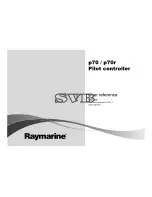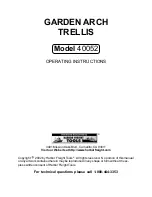
WARNING!
When using mains-powered tools, basic safety precautions, including
the following, should always be followed to reduce risk of fire, electric shock, personal
injury and material damage.
Read the whole manual carefully and make sure you know how to switch the tool off in an emergency, before operating the tool.
Save these instructions and other documents supplied with this tool for future reference.
The charger has been designed for 230V and 240V only. Always check that the power supply corresponds to the voltage on the rating
plate.
Note: The supply of 230V and 240V on Ozito tools are interchangeable for Australia and New Zealand.
This tools charger is double insulated in therefore no earth wire is required.
If the supply cord is damaged, it must be replaced by an electrician or a power tool repairer in order to avoid a hazard.
Note:
Double insulation does not take the place of normal safety precautions when operating this tool. The insulation system is for
added protection against injury resulting from a possible electrical insulation failure within the tool.
The power supply for this products charger should be protected by a residual current device (rated at 30mA or less). A residual current
device reduces the risk of electric shock.
GENERAL POWER TOOL SAFETY WARNINGS
ELECTRICAL SAFETY
WARNING!
Read all safety warnings and all instructions.
Failure to follow the warnings and
instructions may result in electric shock, fire and/or serious injury.
Save all warnings and instructions for future reference. The term “power tool” in the
warnings refers to your mains-operated (corded) power tool or battery-operated (cordless)
power tool.
1. Work area safety
a.
Keep work area clean and well lit
. Cluttered or dark areas invite accidents.
b.
Do not operate power tools in explosive atmospheres, such as in the presence of
flammable liquids, gases or dust.
Power tools create sparks which may ignite the dust or fumes.
c.
Keep children and bystanders away while operating a power tool.
Distractions can cause you to lose
control.
2. Electrical safety
a.
Power tool plugs must match the outlet. Never modify the plug in any way. Do not use
any adapter plugs with earthed (grounded) power tools.
Unmodified plugs and matching outlets will
reduce risk of electric shock.
b.
Avoid body contact with earthed or grounded surfaces, such as pipes, radiators, ranges
and refrigerators.
There is an increased risk of electric shock if your body is earthed or grounded.
c.
Do not expose power tools to rain or wet conditions.
Water entering a power tool will increase the risk
of electric shock.
d.
Do not abuse the cord. Never use the cord for carrying, pulling or unplugging the power
tool. Keep cord away from heat, oil, sharp edges or moving parts.
Damaged or entangled cords
increase the risk of electric shock.
e.
When operating a power tool outdoors, use an extension cord suitable for outdoor use.
Use of a cord suitable for outdoor use reduces the risk of electric shock.
f.
If operating a power tool in a damp location is unavoidable, use a residual current device
(RCD) protected supply.
Use of an RCD reduces the risk of electric shock.
3. Personal safety
a.
Stay alert, watch what you are doing and use common sense when operating a power
tool. Do not use a power tool while you are tired or under the influence of drugs, alcohol
or medication.
A moment of inattention while operating power tools may result in serious personal injury.
b.
Use personal protective equipment. Always wear eye protection.
Protective equipment such as dust
mask, non-skid safety shoes, hard hat, or hearing protection used for appropriate conditions will reduce personal injuries.
c.
Prevent unintentional starting. Ensure the switch is in the off-position before connecting
to power source and/or battery pack, picking up or carrying the tool.
Carrying power tools with
your finger on the switch or energising power tools that have the switch on invites accidents.
d.
Remove any adjusting key or wrench before turning the power tool on.
A wrench or a key left
attached to a rotating part of the power tool may result in personal injury.
e.
Do not overreach. Keep proper footing and balance at all times.
This enables better control of the
power tool in unexpected situations.
f.
Dress properly. Do not wear loose clothing or jewellery. Keep your hair, clothing and
gloves away from moving parts.
Loose clothes, jewellery or long hair can be caught in moving parts.
g.
If devices are provided for the connection of dust extraction and collection facilities,
ensure these are connected and properly used.
Use of dust collection can reduce dust-related hazards.
4. Power tool use and care
a.
Do not force the power tool. Use the correct power tool for your application.
The correct
power tool will do the job better and safer at the rate for which it was designed.
b.
Do not use the power tool if the switch does not turn it on and off.
Any power tool that cannot be
controlled with the switch is dangerous and must be repaired.
c.
Disconnect the plug from the power source and/or the battery pack from the power
tool before making any adjustments, changing accessories, or storing power tools.
Such
preventive safety measures reduce the risk of starting the power tool accidentally.
d.
Store idle power tools out of the reach of children and do not allow persons unfamiliar
with the power tool or these instructions to operate the power tool.
Power tools are dangerous in
the hands of untrained users.
e.
Maintain power tools. Check for misalignment or binding of moving parts, breakage of
parts and any other condition that may affect the power tool’s operation. If damaged,
have the power tool repaired before use.
Many accidents are caused by poorly maintained power tools.
f.
Keep cutting tools sharp and clean.
Properly maintained cutting tools with sharp cutting edges are less likely to
bind and are easier to control.
g.
Use the power tool, accessories and tool bits etc. in accordance with these instructions,
taking into account the working conditions and the work to be performed.
Use of the power
tool for operations different from those intended could result in a hazardous situation.
5. Battery tool use and care
a.
Recharge only with the charger specified by the manufacturer.
A charger that is suitable for one
type of battery pack may create a risk of fire when used with another battery pack.
b.
Use power tools only with specifically designated battery packs.
Use of any other battery packs may
create a risk of injury and fire.
c.
When battery pack is not in use, keep it away from other metal objects, like paper clips,
coins, keys, nails, screws or other small metal objects, that can make a connection from
one terminal to another.
Shorting the battery terminals together may cause burns or a fire.
d.
Under abusive conditions, liquid may be ejected from the battery; avoid contact. If
contact accidentally occurs, flush with water. If liquid contacts eyes, additionally seek
medical help.
Liquid ejected from the battery may cause irritation or burns.
6. Service
a.
Have your power tool serviced by a qualified repair person using only identical
replacement parts.
This will ensure that the safety of the power tool is maintained.
POLE HEDGE TRIMMER SAFETY WARNINGS
• Keep all parts of the body away from the cutter blade.
Do not remove cut material or hold
material to be cut when blades are moving. Make sure the switch is off when clearing jammed material. A moment
of inattention while operating the hedge trimmer may result in serious personal injury.
• Carry the hedge trimmer by the handle with the cutter blade stopped.
When
transporting or storing the hedge trimmer always fit the blade cover. Proper handling of the hedge trimmer will
reduce possible personal injury from the cutter blades.
• Hold the power tool by insulated gripping surfaces only, because the cutter blade
may contact hidden wiring or its own cord.
Cutter blades contacting a “live” wire may make
exposed metal parts of the power tool “live” and could give the operator an electric shock.
• Perform visual inspection on the hedge being trimmed.
Ensure that there are no wire fences
or foreign objects that may come into contact with the Pole Hedge Trimmer during operation.
• Inspect and maintain the Pole Hedge Trimmer regularly.
Have the Pole Hedge Trimmer
repaired by an authorized repairer.
• Never allow children or people unfamiliar with these instructions to use the Pole Hedge Trimmer.
• Avoid using the Pole Hedge Trimmer, while people, especially children or pets are nearby.
• Use the Pole Hedge Trimmer only in daylight.
• Never operate the Pole Hedge Trimmer with a damaged cutting blade.
• Switch on the Pole Hedge Trimmer only when hands and feet are away from the cutting blades.
• Use only manufacturer’s recommended replacement parts and accessories.
• Always disconnect the battery from the Pole Hedge Trimmer and put the blade cover on when leaving the Pole Hedge
Trimmer unattended.
• Disconnect the battery from the Pole Hedge Trimmer before carrying out any maintenance or cleaning work.
• When not in use, store the Pole Hedge Trimmer out of the reach of children
• Face the cutting blades away from yourself, other people and animals while the power is connected to the Pole
Hedge Trimmer (especially during operation).
• Use both handles and shoulder strap.
• Keep ventilation openings clear of debris. Keep handles dry, clean and free of oil and grease.
• Never reach underneath the Pole Hedge Trimmer cutting blades until it has completely stopped and the power has
been disconnected.
This appliance is not intended for use by persons (including children) with reduced
physical, sensory or mental capabilities, or lack of experience and knowledge,
unless
they have been given supervision or instruction concerning use of the appliance by a person responsible for their
safety.




































